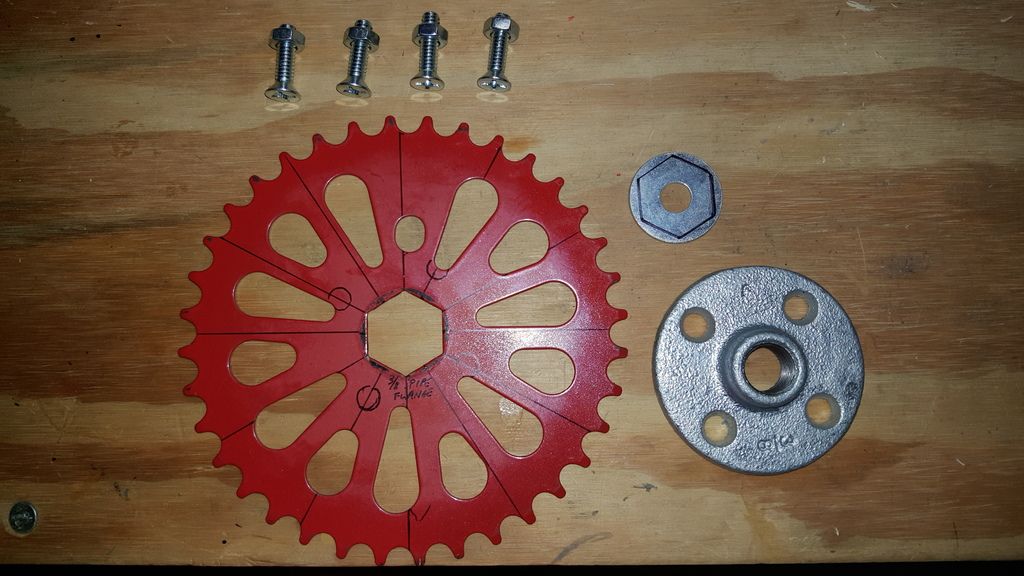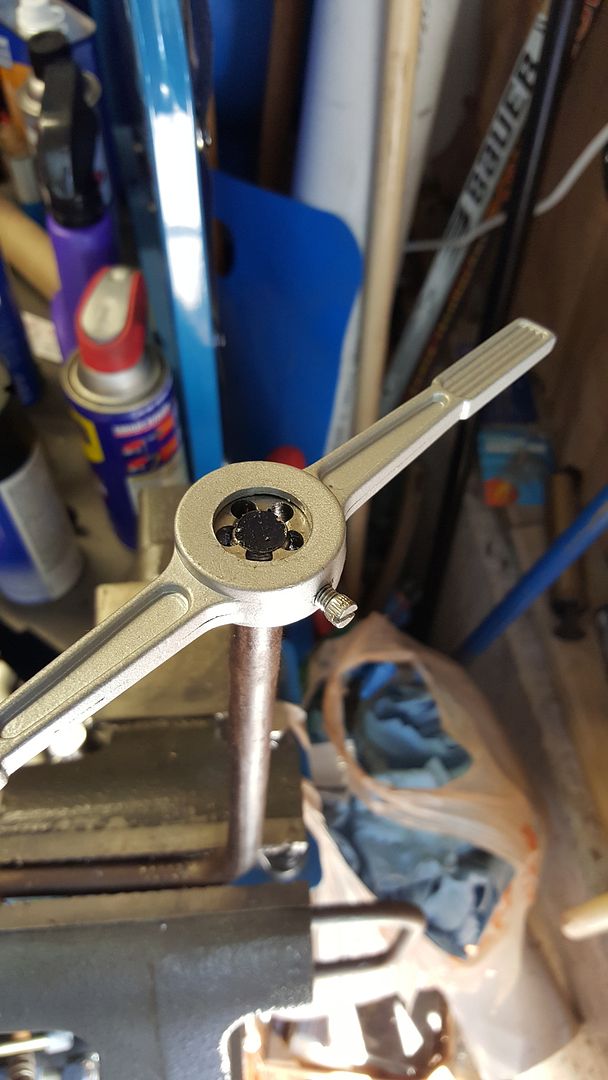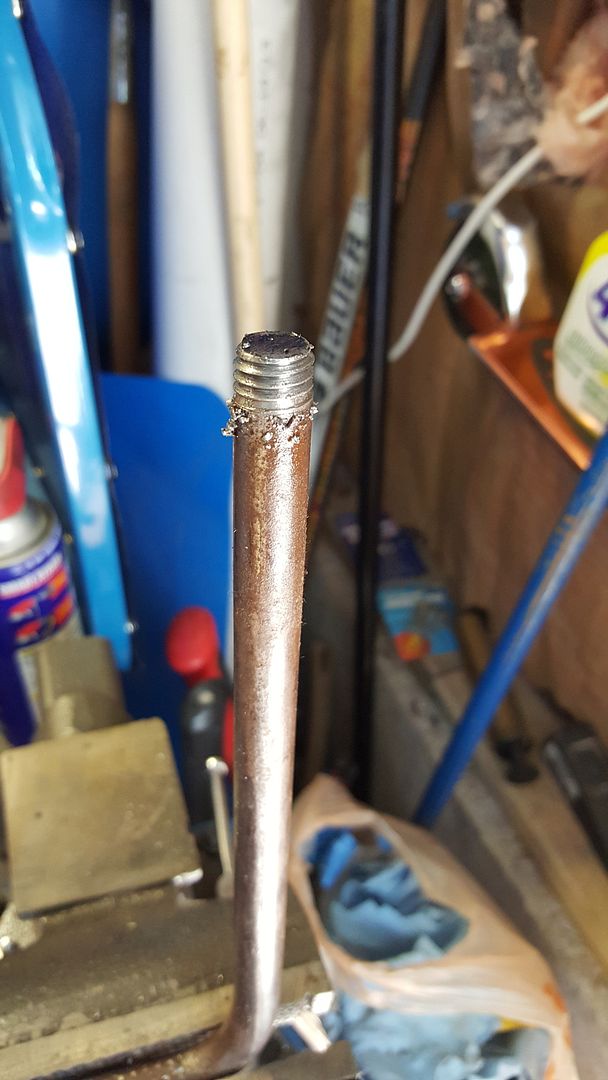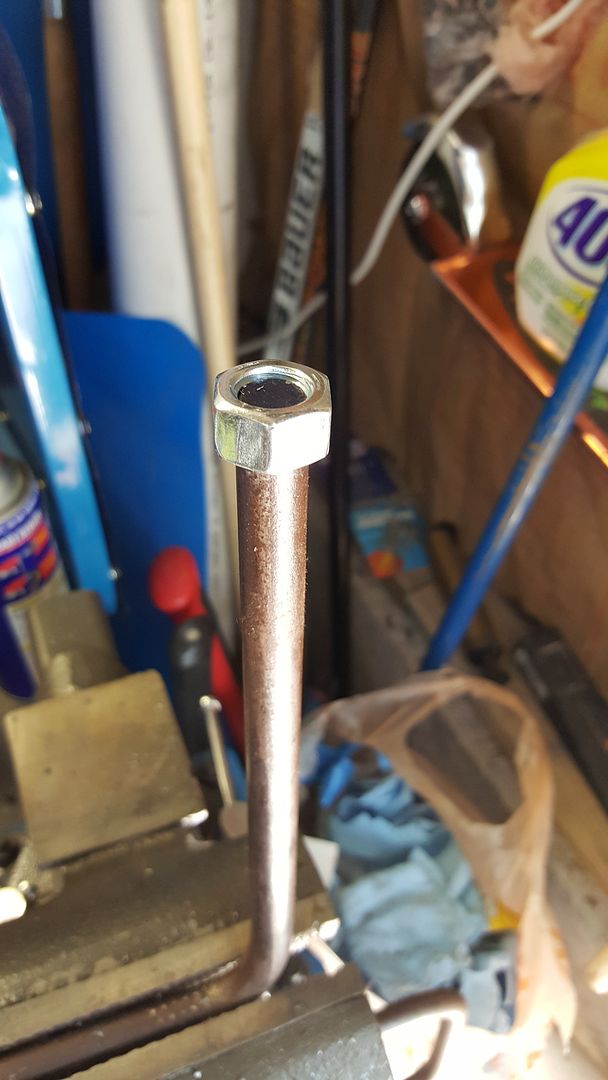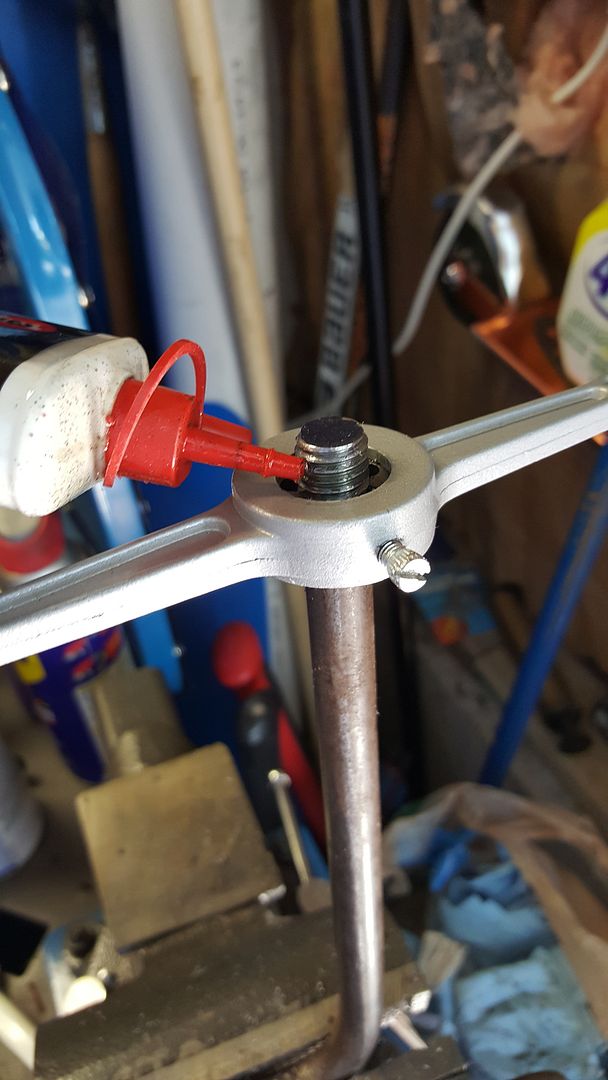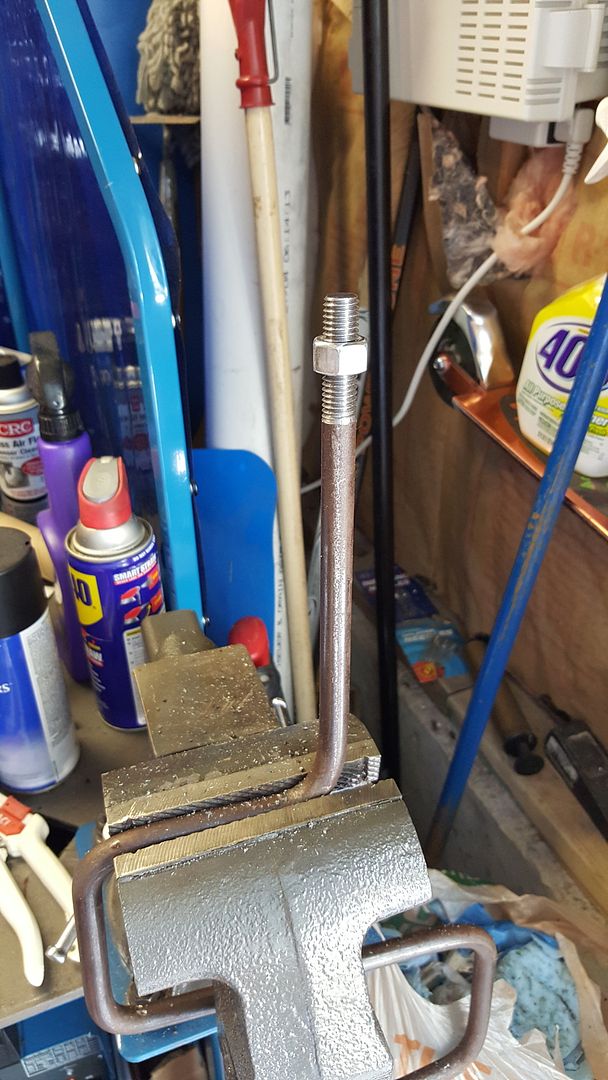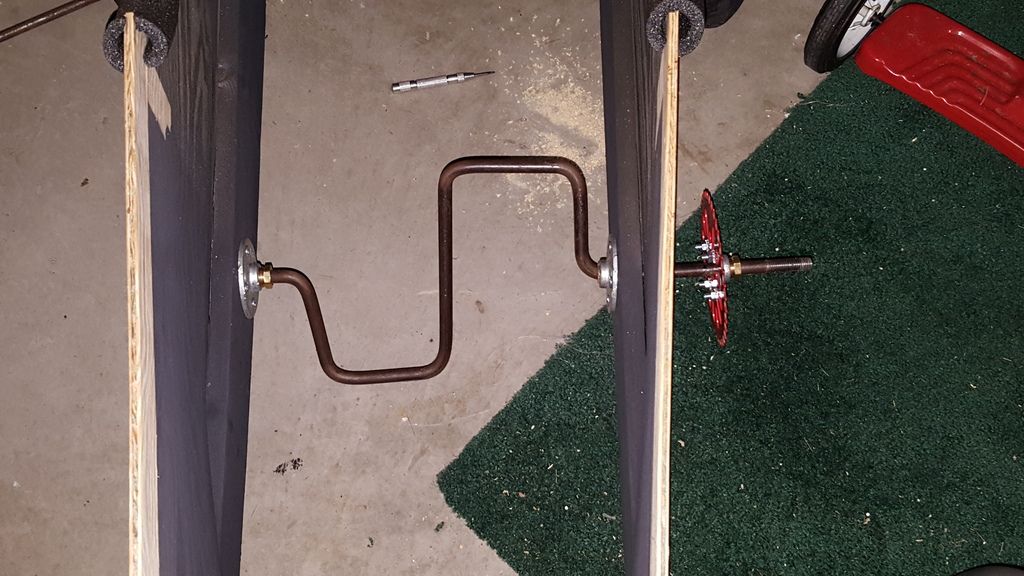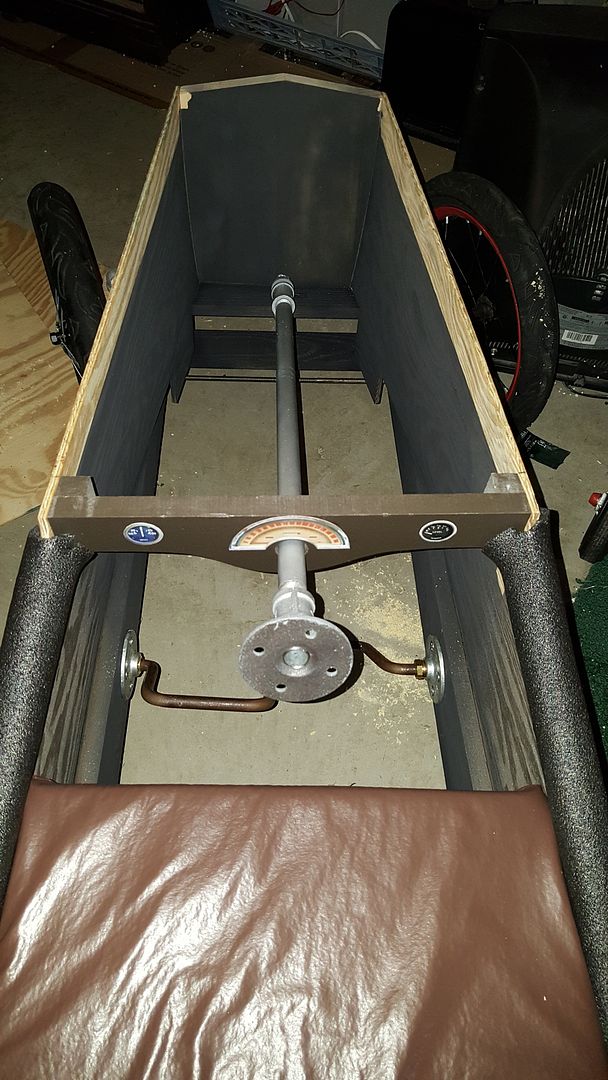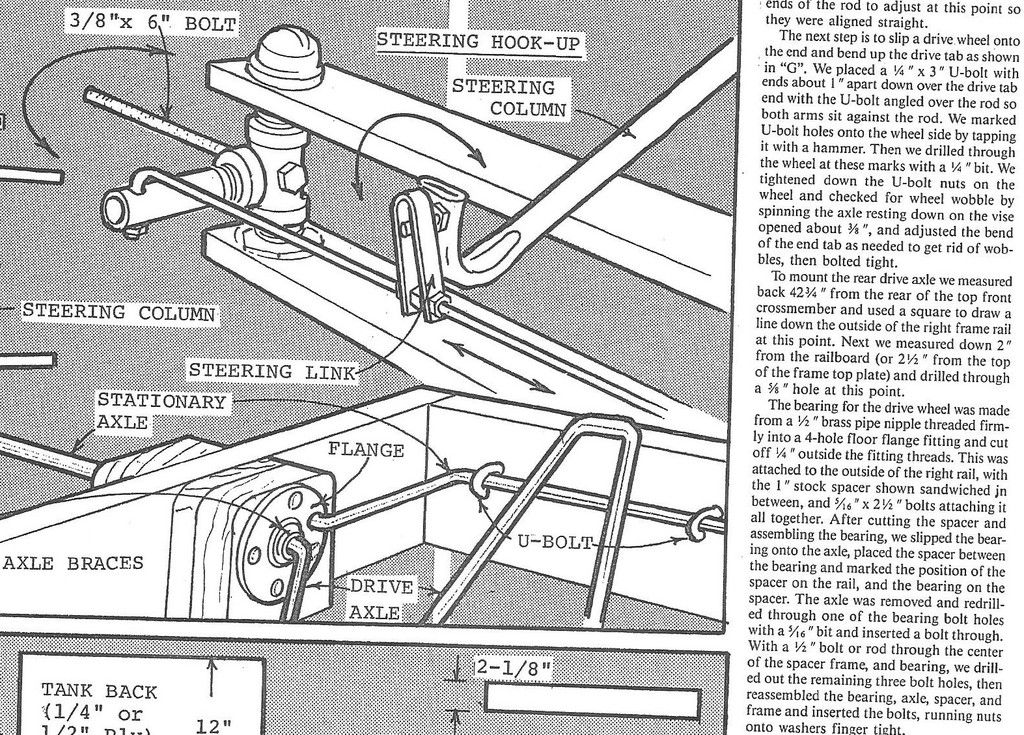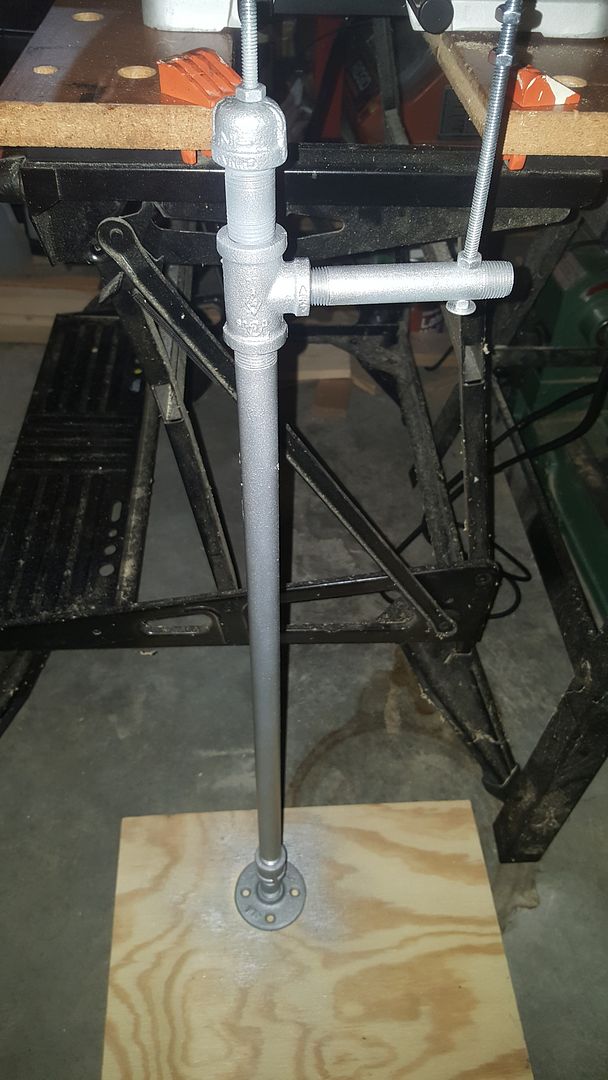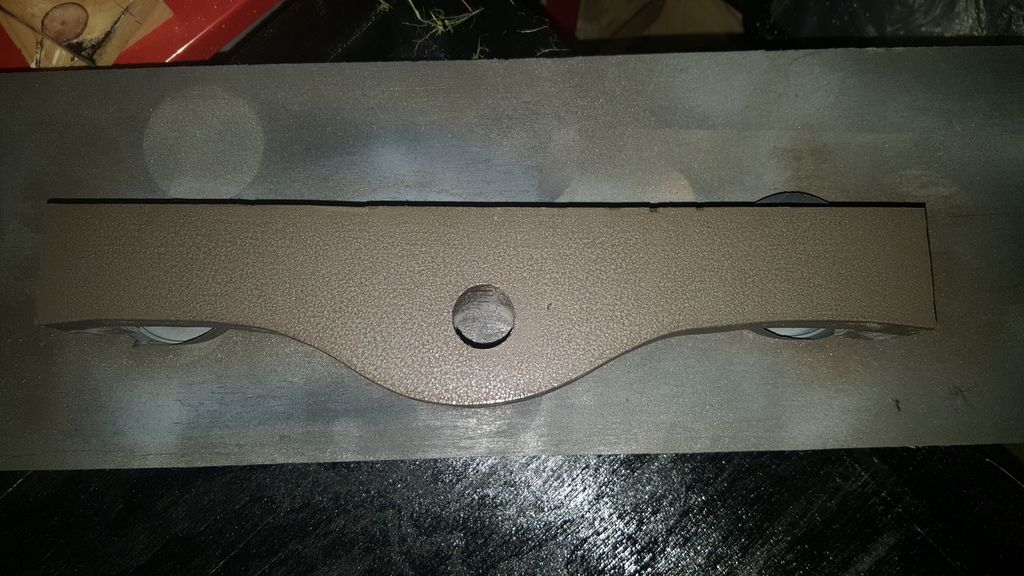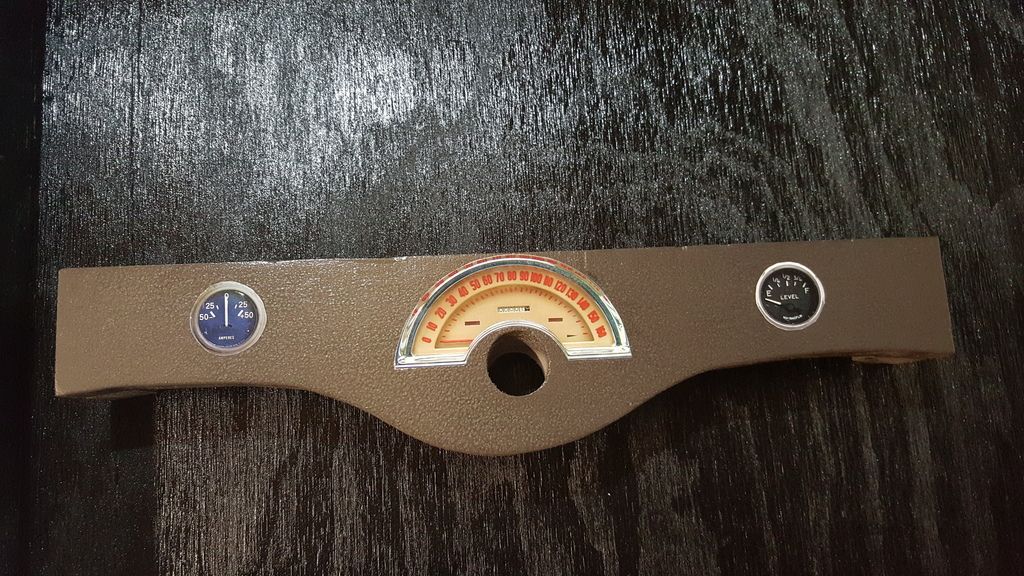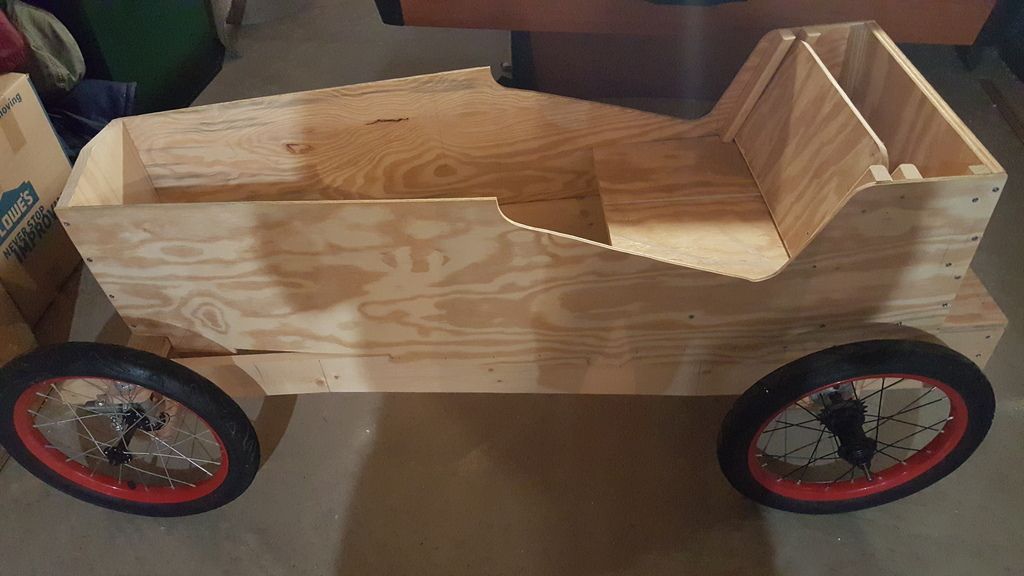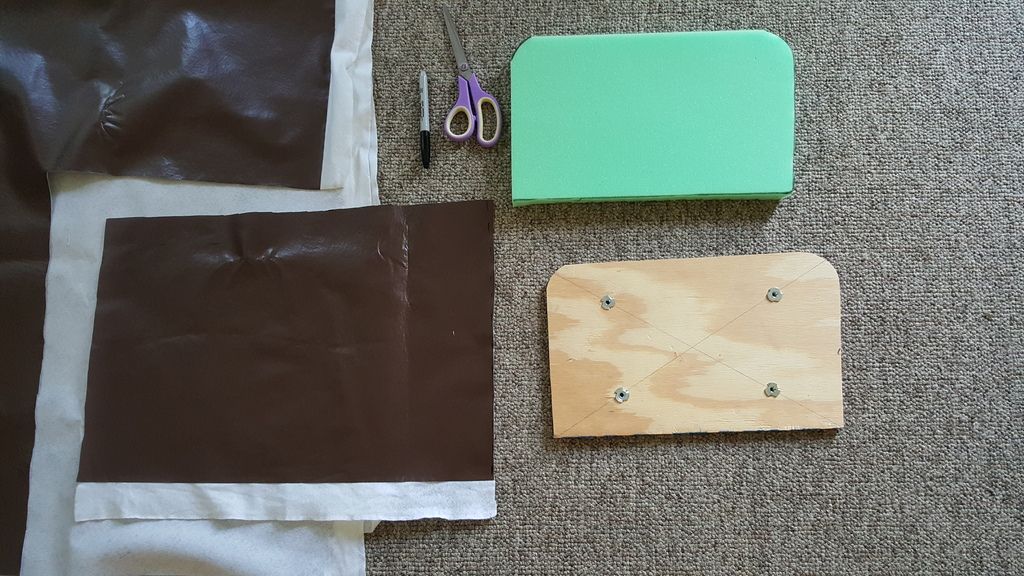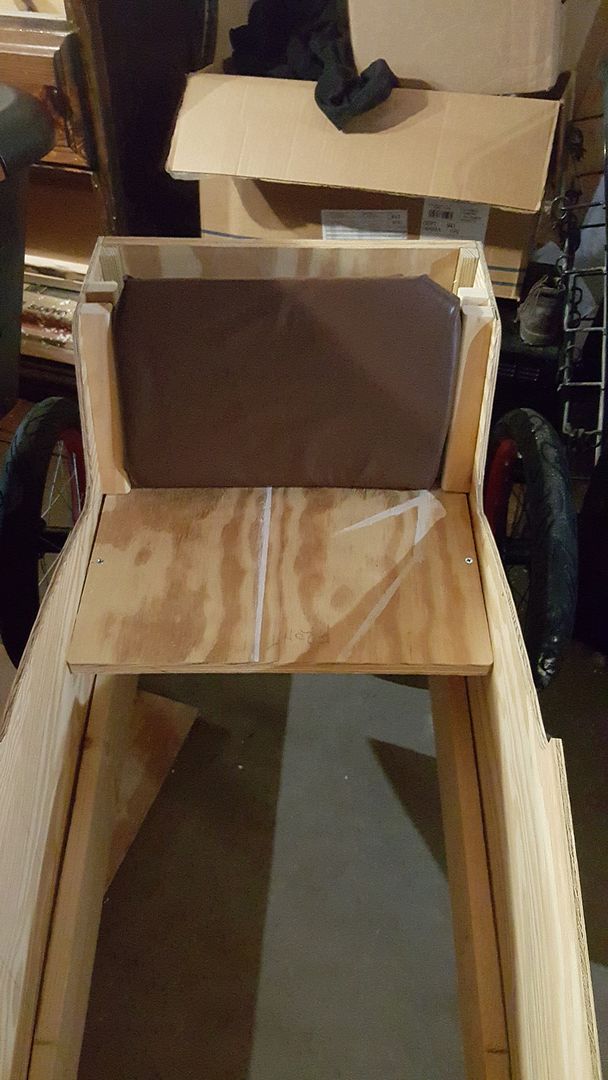So far, most of the pedal car construction has been pretty routine. Creating the kingpins was different, since I've never done anything with iron pipe before, but not too difficult. Now, it is time to give this thing a driveline and that's going to be the most difficult part of the whole project.
As I mentioned in my last post, I've mined another person's blog for ideas and have adopted their approach to the driveline and abandoned the plans. The driveline will use the sprocket from the donor bike, along with a home made pedal crank. I'll also make wooden pedals to go on the crank and save my grandkids feet, but that'll be on another day. I'll also use the chains from the donor bikes and meld them into one appropriate length chain. I'll do that after I find the chain splitter that I bought and now can't find. The sprocket will be attached to a pipe floor flange with a bronze insert acting as a bushing. I'll thread the end of the crank so that it can accept nuts that I will use to sandwich the sprocket/flange onto the crank. Hopefully it will turn with the crank as it is pedalled and not just spin without turning the back wheels. Here are the sprocket, flange and nuts/bolts:
You can see how I figured out the center of the sprocket and how I centered the floor flange. The fender washer is marked, so that I can grind it to match the hexagonal opening of the sprocket. It probably isn't necessary, but I'm going to do it anyway. Originally, I was going to use the 3/8" floor flange. Then I realized that my 1/2" crank wouldn't fit, so I remarked and drilled the sprocket for a 1/2" floor flange.
I then bent a 1/2" thick steel rod to make the crank into the shape necessary for a pedal car. I have a 2" end piece, followed by 4"x4" U shaped areas for each of the actual pedals, followed by about 8" for attaching the sprocket. After bending the rod into the crank shape, I needed to make threads for the nuts that will hold the sprocket onto the crank. I put the crank into the vise and sanded a small bevel into the top of the crank rod. Using the thread cutting die for a couple of passes, the die increased the bevelled edge. It looked like this:
That shows how the die actually works. As it cuts into the metal, it first shaves away excess metal, then it cuts the actual threads into the rod. After several complete rotations of the die, it looks like this:
There you can see the rough shape of the crank, as it sits in the vise and you can see the die on the end of the crank. Because I'm cutting coarse threads into the rod instead of fine threads, the die is having to take a lot of metal off of the rod. Because of that, the metal flakes that are coming off are really large. That is causing me to have to stop and clean the rod and die after each 1/8th turn of the die. That makes for very slow going. In the next pic, you can see I've made it to the depth of the die. It looked like this with the die on the rod:
And this with the die off:
As you can see, at the bottom of the threads are those metal shavings from the cutting process. They really are quite large compared to when I was cutting fine threads earlier in the project. I like to do a test fit at this point, to make sure everything will fit properly. It looked like this:
Not too shabby...now only another 2-3 inches of threads to cut. Piece of cake. The way that I learned to do it was to turn the die handle about a 1/4 turn (or less) then back it off and cut off the metal shavings. Then rotate forward again, repeating the process. Along the way, you should apply a small amount of oil to lubricate the die and aid in the cutting process. Sometimes it looks like a lot of oil, but it really is only a drop or two each time. I rotate the die all the way down on the new threads, apply a drop of oil just above the die, then rotate the die back up through the oil, then back down for the next cut. Applying the oil looks like this:
In addition to lubricating the die, it flushes out the shavings that are stuck in the die. In this pic, you can see the set screw that holds the die in the handle. As luck would have it, I stripped the threads that hold the set screw in place and had to stop for the day. Here is how far that I got:
All in all, it is starting to look pretty good. I'm going to test fit it onto the car and see how much further I need to go with the threads. But, until I get a new handle, I'm kinda stuck. That's all for now.
UPDATE:
I had some time this morning, so I cut the bronze bushing flush with the pipe floor flange and did a test fit on the pedal crank. It looked like this:
Unfortunately, you can see in this pic that the crank is not true. I was a little off when I bent it. I'm going to try to straighten it out, but you can see how it will fit within the car body, approximately where I'm going to attach the sprocket and how much more threads I'll have to cut. If I can't straighten it, then it's scrap and I get to start over....
After the test fit of the crank, I installed the dashboard and the steering column. It looked like this:
And with the steering wheel attached:
Before installing the crank, I had taken a rough measurement of where to put it, based on my grandson sitting in the car. However, once it was installed and he was working the crank, it was clear that the whole crank assembly should be moved forward. That will give his knees more clearance. So, in the interim, I'll make that change. I still need to buy a new handle for my dies, too. We did do a test of the steering in the driveway, with my grand kids steering and me pushing. The steering is slow to respond, but when it does, it rockets off in that direction. It will definitely take some practice on their part to make it a smooth ride. But that is some time down the road....
All about working on and restoring my 1953 Chevy 3100 (1/2 ton) pickup truck including the inline 6 235 engine
1953 chevy truck ad
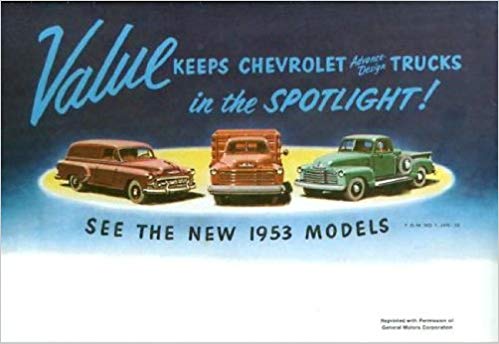
Friday, September 18, 2015
Monday, September 7, 2015
Laboring on the Pedal Car on Labor Day
After getting my chores done, I decided to spend my Labor Day Holiday doing a little work on the pedal car. That made for quite a sweaty day, but progress was made. Right now, I'm fixing a few things that I had already done, but didn't like, finalizing my plans on the steering and making ready for the really hard part, which is up next.
For starters, I did finalize my plans for the steering. I mined the ideas from another blog and am using their solution. In the following picture, you will notice the position of the steering components...
The linkage is in front of the axles. Now, notice the position of the linkage...
It's behind the axles. Why? I'll show you.... Here is a shot of how the plans wanted it done:
You can see the linkage is in front of the axles, where I originally had them. The plans then want you to flatten the end of a piece of iron pipe and then bend it 90 degrees, then drill a hole for a screw. At that point, you attach a U shaped piece of metal to a threaded rod, attach nuts to hold the metal piece in place, then bend the ends 90 degrees to fit in holes drilled in the metal pipe pieces that are a part of the axle assembly (aka, king pins). Here's another shot from a different drawing:
This is also a really good example of what I was talking about in my post where I complained about the quality of the plans. Here you have 2 separate drawings dealing with the exact same topic. The text that addresses this issue is on yet another page. Also, you can clearly see that in the foreground of the pic above, they have mashed 2 separate drawings together, to save space in the magazine article. Also, you can see the column of text from the magazine, instead of step by step instructions. Anyway, with some detective work, you can usually manage to piece it all together, although I have made some mistakes that required trashing some of my work and starting over, because of misinterpreting the plans....
But I digress. The plans that I'm using for the steering came from another blog. It uses more of the metal pipe to construct a steering column. However, instead of smashing and bending the end of the pipe, it used a T connector and short pieces of pipe to make an attachment point for a screw that will attach to the same bent metal piece. Another change is that I won't be using a bent threaded rod. Instead, I made my own threaded rod out of a piece of plain rod. I then attached tie rod ends (there's another name for them, but I can't remember right now). The tie rod ends give me an attachment point to the king pins and will allow for a similar nut/bent metal piece arrangement. The big difference this time is that it will be behind the king pins.
That's why the king pins face rearward and the threaded rod that is visible between the car body sides is there. The steering column (which is upside down in the pic, since the paint is still drying) looks like this:
The bolt sticking out of the top will act as a guide pin. I will drill a hole in the front of the car body above, that is angled to match the hole in the dash. The guide pin will keep the steering column from wobbling around. The bolt that is very long, to the right of the pic is the bolt that will connect to the bent metal piece on the steering linkage. The dash currently looks like this:
I plan to download a pic of a speedometer and other dash gauges to round out the look. It is painted the same color as the pieces that I restored for the 53 Chevy. Edit: I did download a couple of pics of dashboard components and used an adhesive spray on the backs and stuck them onto the dash. Turned our pretty good and looks like this:
Here we go again with rotated pics....
Lastly, I put pipe insulation over the edge of the cockpit. I will eventually cover the insulation with more of the vinyl, to give that fake leather look. It looks like this:
So, I've really gone as far as I can without addressing the drive system. I know how I want to do it, it's just going to be a little tough to do. Maybe next weekend....
For starters, I did finalize my plans for the steering. I mined the ideas from another blog and am using their solution. In the following picture, you will notice the position of the steering components...
The linkage is in front of the axles. Now, notice the position of the linkage...
It's behind the axles. Why? I'll show you.... Here is a shot of how the plans wanted it done:
You can see the linkage is in front of the axles, where I originally had them. The plans then want you to flatten the end of a piece of iron pipe and then bend it 90 degrees, then drill a hole for a screw. At that point, you attach a U shaped piece of metal to a threaded rod, attach nuts to hold the metal piece in place, then bend the ends 90 degrees to fit in holes drilled in the metal pipe pieces that are a part of the axle assembly (aka, king pins). Here's another shot from a different drawing:
This is also a really good example of what I was talking about in my post where I complained about the quality of the plans. Here you have 2 separate drawings dealing with the exact same topic. The text that addresses this issue is on yet another page. Also, you can clearly see that in the foreground of the pic above, they have mashed 2 separate drawings together, to save space in the magazine article. Also, you can see the column of text from the magazine, instead of step by step instructions. Anyway, with some detective work, you can usually manage to piece it all together, although I have made some mistakes that required trashing some of my work and starting over, because of misinterpreting the plans....
But I digress. The plans that I'm using for the steering came from another blog. It uses more of the metal pipe to construct a steering column. However, instead of smashing and bending the end of the pipe, it used a T connector and short pieces of pipe to make an attachment point for a screw that will attach to the same bent metal piece. Another change is that I won't be using a bent threaded rod. Instead, I made my own threaded rod out of a piece of plain rod. I then attached tie rod ends (there's another name for them, but I can't remember right now). The tie rod ends give me an attachment point to the king pins and will allow for a similar nut/bent metal piece arrangement. The big difference this time is that it will be behind the king pins.
That's why the king pins face rearward and the threaded rod that is visible between the car body sides is there. The steering column (which is upside down in the pic, since the paint is still drying) looks like this:
The bolt sticking out of the top will act as a guide pin. I will drill a hole in the front of the car body above, that is angled to match the hole in the dash. The guide pin will keep the steering column from wobbling around. The bolt that is very long, to the right of the pic is the bolt that will connect to the bent metal piece on the steering linkage. The dash currently looks like this:
I plan to download a pic of a speedometer and other dash gauges to round out the look. It is painted the same color as the pieces that I restored for the 53 Chevy. Edit: I did download a couple of pics of dashboard components and used an adhesive spray on the backs and stuck them onto the dash. Turned our pretty good and looks like this:
Here we go again with rotated pics....
Lastly, I put pipe insulation over the edge of the cockpit. I will eventually cover the insulation with more of the vinyl, to give that fake leather look. It looks like this:
So, I've really gone as far as I can without addressing the drive system. I know how I want to do it, it's just going to be a little tough to do. Maybe next weekend....
Saturday, September 5, 2015
Seating for One, Please
Got quite a workout today while sealcoating the driveway. Thirty five gallons of seal and four hours later, it looked pretty good (sorry, no pics of it...). After that workout, my truck and pedal car time was very limited. So a quick project on the pedal car was to upholster the seats. My thought was to use the seat parts that were in the car last week as mounting points for seat cushions, which I had to make. The car looked like this last week:
You can see the seat back can be removed, as it sits in between 2 pieces of wood on each side of the car body. The seat bottom is glued and screwed to the frame. I used the seat back as a guide and created a cushion back that was 1/4" smaller from side to side and about an inch taller than the seat back. That way the seat back could still slide down the guides and the seat cushion would be taller than the seat back and would keep the riders back from hitting the wooden seat back. I bought foam cushions and vinyl (fake leather looking) material from Joann Fabrics last weekend. I decided to use T nuts inside of the cushion as a way to connect the cushion to the seat back, so it wouldn't slide around. The seat cushion back with T nuts installed, foam and vinyl looked like this:
I used the wood as a template and marked the foam with the Sharpie and just cut it out with plain old scissors.
I decided that the inside of the car would be painted the same inside color as my 53 Chevy truck. So I painted the seat back and when it was dry, attached the cushion to the seat back. It looked like this:
Here you can see that the seat back is wider than the cushion, but the cushion is taller than the frame. You may note the holes in the seat back. This piece of wood was initially part of the 4'x8' sheet of plywood that we used for our Christmas tree train layout. The 2 holes were where train tracks were connected. We later decided to pare down the board to a 4'x4' board and this half of the plywood sheet was excess. So, in keeping with my goal of reusing as much wood as possible, this found its way into the pedal car. You can also see the machine screws that attach the seat back to the cushion by way of the embedded T nuts. A test fit of the cushion shows that it fit pretty well, although I did have some issues getting the vinyl to bend around the corner radii on the top of the cushion. But I knew that this would be an issue, so I wasn't too upset. The test fit looked like this:
From here, I took measurements of the seat bottom and transferred them to a 1/4" sheet of plywood and then cut it out. I used it as a template for the foam and followed the same process for the seat bottom cushion. I also embedded T nuts in the seat bottom cushion, so it won't slide off when someone is riding. Once added to the pedal car it looked like this:
All in all, not too shabby. While I was out buying the sealcoat, I also bought the materials to make the steering column. I'll try to work on that tomorrow.
You can see the seat back can be removed, as it sits in between 2 pieces of wood on each side of the car body. The seat bottom is glued and screwed to the frame. I used the seat back as a guide and created a cushion back that was 1/4" smaller from side to side and about an inch taller than the seat back. That way the seat back could still slide down the guides and the seat cushion would be taller than the seat back and would keep the riders back from hitting the wooden seat back. I bought foam cushions and vinyl (fake leather looking) material from Joann Fabrics last weekend. I decided to use T nuts inside of the cushion as a way to connect the cushion to the seat back, so it wouldn't slide around. The seat cushion back with T nuts installed, foam and vinyl looked like this:
I used the wood as a template and marked the foam with the Sharpie and just cut it out with plain old scissors.
I decided that the inside of the car would be painted the same inside color as my 53 Chevy truck. So I painted the seat back and when it was dry, attached the cushion to the seat back. It looked like this:
Here you can see that the seat back is wider than the cushion, but the cushion is taller than the frame. You may note the holes in the seat back. This piece of wood was initially part of the 4'x8' sheet of plywood that we used for our Christmas tree train layout. The 2 holes were where train tracks were connected. We later decided to pare down the board to a 4'x4' board and this half of the plywood sheet was excess. So, in keeping with my goal of reusing as much wood as possible, this found its way into the pedal car. You can also see the machine screws that attach the seat back to the cushion by way of the embedded T nuts. A test fit of the cushion shows that it fit pretty well, although I did have some issues getting the vinyl to bend around the corner radii on the top of the cushion. But I knew that this would be an issue, so I wasn't too upset. The test fit looked like this:
From here, I took measurements of the seat bottom and transferred them to a 1/4" sheet of plywood and then cut it out. I used it as a template for the foam and followed the same process for the seat bottom cushion. I also embedded T nuts in the seat bottom cushion, so it won't slide off when someone is riding. Once added to the pedal car it looked like this:
All in all, not too shabby. While I was out buying the sealcoat, I also bought the materials to make the steering column. I'll try to work on that tomorrow.
Friday, September 4, 2015
Good Day, Bonjour, Guten Tag....
Good Day Everyone,
I've added a Google translator to the bar on the right. Now everyone should be able to read what I'm writing.
Enjoy!
Gray Ghost 53
I've added a Google translator to the bar on the right. Now everyone should be able to read what I'm writing.
Enjoy!
Gray Ghost 53
Subscribe to:
Posts (Atom)
